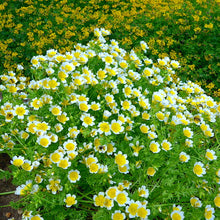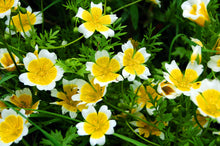Limnanthes douglasii
This annual wildflower is an absolute beauty. In early spring, its low and luscious foliage will create a bright green carpet soon to be adorned with creamy-white flowers with bright yellow centers. These darling blooms support pollinators and attract other beneficial insects to the habitat garden, as well as earn it another common name of “poached egg plant”. It thrives in heavy clay soils that drain slowly and, in this condition, will reseed itself prolifically, becoming a consistent spring and early summer groundcover.
- Plant type/canopy layer: deciduous, annual, herbaceous plant
- Size at maturity: 6-12” tall, 6-12” wide
- Light requirements: full sun, part sun/part shade
- Moisture requirements: moist to seasonally wet soil, slow-draining clay
- Bloom time: March - July
- Growth rate/ease: fast growth rate, easy to grow
- Wildlife support: flowers attract and provide nectar to adult bees and butterflies and attract pest predators such as hoverflies and ladybugs; overall plant is a caterpillar host and larval food source for at least one species of native moth
- Native habitat/range: grows in wet, grassy habitats, such as vernal pools and spring meadows from southern Oregon to central California, west of the Cascades and Sierra Nevadas. Portland Plant List - no.
- Special features & uses: landscape uses include pollinator gardens, meadowscapes, and groundcover
Gardening with Douglas Meadowfoam: Are you looking for a plant to populate those tough, wet areas with heavy clay soil? Meadowfoam is your match! This charming wildflower requires most-to-full sun areas with slow-draining soils that will keep its feet wet throughout the growing season. Once the area dries out, you can prolong its lush growth and spectacular blooms by providing supplemental moisture. This plant is a self-sowing annual, meaning each individual plant only grows for one season, then spreads seed that will grow next year, before dying entirely. In the right conditions, it will proceed prolifically, which is typically a welcomed trait since it is so pleasing to the eyes and beneficial to our gardens’ ecosystem. If time/interest allows, some people choose to cut back after flowering.
Seed Sowing Instructions: Recommend sowing between September and November or in March so that seeds will benefit from seasonal rains. Scatter seed on loose-weed free soil. Seed can be lightly raked in to increase seed-to-soil contact, but be careful not to cover the seed with more than 1/4" soil. If sowing in April or May, seeds will benefit from supplemental water to encourage strong growth the first year. Each packet contains approximately 100 seeds.
This is also an easy one to collect, replant, and/or share the seeds once established. Simply allow seed pods to dry on the plant and then break them open to collect the seeds. Sow seeds in spring or autumn.
Photo credit 1: "Limnanthes douglasii" by It's No Game is licensed under CC BY 2.0
Photo credit 2: "Limnanthes douglasii 001" by delirium florens is licensed under CC BY 2.0




